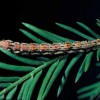 The erythrina leafminer is a member of the genus Leucoptera, which are leaf borers that can cause severe damage to plant crops, such as coffee or apples. Even though these moths are 1/20 to 1/10 the size of an average moth, they can cause serious damage. Leucoptera erythrinella is a pest of the coral bean and other members of the genus Erythrina. The larvae feed inside the leaves, making elaborate and characteristic mines, which from a distance appear to be discolorations of the leaf itself. This 5-page fact sheet was written by Andrei Sourakov, and published by the UF Department of Entomology and Nematology, January 2014.
The erythrina leafminer is a member of the genus Leucoptera, which are leaf borers that can cause severe damage to plant crops, such as coffee or apples. Even though these moths are 1/20 to 1/10 the size of an average moth, they can cause serious damage. Leucoptera erythrinella is a pest of the coral bean and other members of the genus Erythrina. The larvae feed inside the leaves, making elaborate and characteristic mines, which from a distance appear to be discolorations of the leaf itself. This 5-page fact sheet was written by Andrei Sourakov, and published by the UF Department of Entomology and Nematology, January 2014.
http://edis.ifas.ufl.edu/in1023
Tag: Lepidoptera
Cypress looper Anacamptodes pergracilis (Hulst) (Insecta: Lepidoptera: Geometridae) (EENY303/IN986)
 Anacamptodes pergracilis (Hulst), commonly known as the cypress looper, drew considerable attention in late summer of 1980 with the unexpected defoliation of nearly 28,000 ha of cypress trees in USFS-NPS Big Cypress National Preserve (Collier and Monroe counties). Currently, cypress looper populations are at low levels, even in the Fisheating Creek (Glades County) area, a perennial generator of significant cypress looper defoliation over the past 20 years. This 3-page fact sheet was written by Wayne N. Dixon, and published by the UF Department of Entomology and Nematology, April 2013.
Anacamptodes pergracilis (Hulst), commonly known as the cypress looper, drew considerable attention in late summer of 1980 with the unexpected defoliation of nearly 28,000 ha of cypress trees in USFS-NPS Big Cypress National Preserve (Collier and Monroe counties). Currently, cypress looper populations are at low levels, even in the Fisheating Creek (Glades County) area, a perennial generator of significant cypress looper defoliation over the past 20 years. This 3-page fact sheet was written by Wayne N. Dixon, and published by the UF Department of Entomology and Nematology, April 2013.
http://edis.ifas.ufl.edu/in986
Bagworm, Thyridopteryx ephemeraeformis Haworth (Insecta: Lepidoptera: Psychidae) (EENY548/IN981)
 North American bagworm can feed on over 50 families of deciduous and evergreen trees and shrubs. Severe infestations can damage the aesthetics and health of host plants, especially juniper and arborvitae species. Many of the preferred host plants do not grow well below the USDA hardiness zone 8A, but due to its wide host range, high female fecundity, and method of dispersal, bagworm can still be problematic in the Florida landscape. This 5-page fact sheet was written by Brooke L. Moffis and Steven P. Arthurs, and published by the UF Department of Entomology and Nematology, March 2013.
North American bagworm can feed on over 50 families of deciduous and evergreen trees and shrubs. Severe infestations can damage the aesthetics and health of host plants, especially juniper and arborvitae species. Many of the preferred host plants do not grow well below the USDA hardiness zone 8A, but due to its wide host range, high female fecundity, and method of dispersal, bagworm can still be problematic in the Florida landscape. This 5-page fact sheet was written by Brooke L. Moffis and Steven P. Arthurs, and published by the UF Department of Entomology and Nematology, March 2013.
http://edis.ifas.ufl.edu/in981